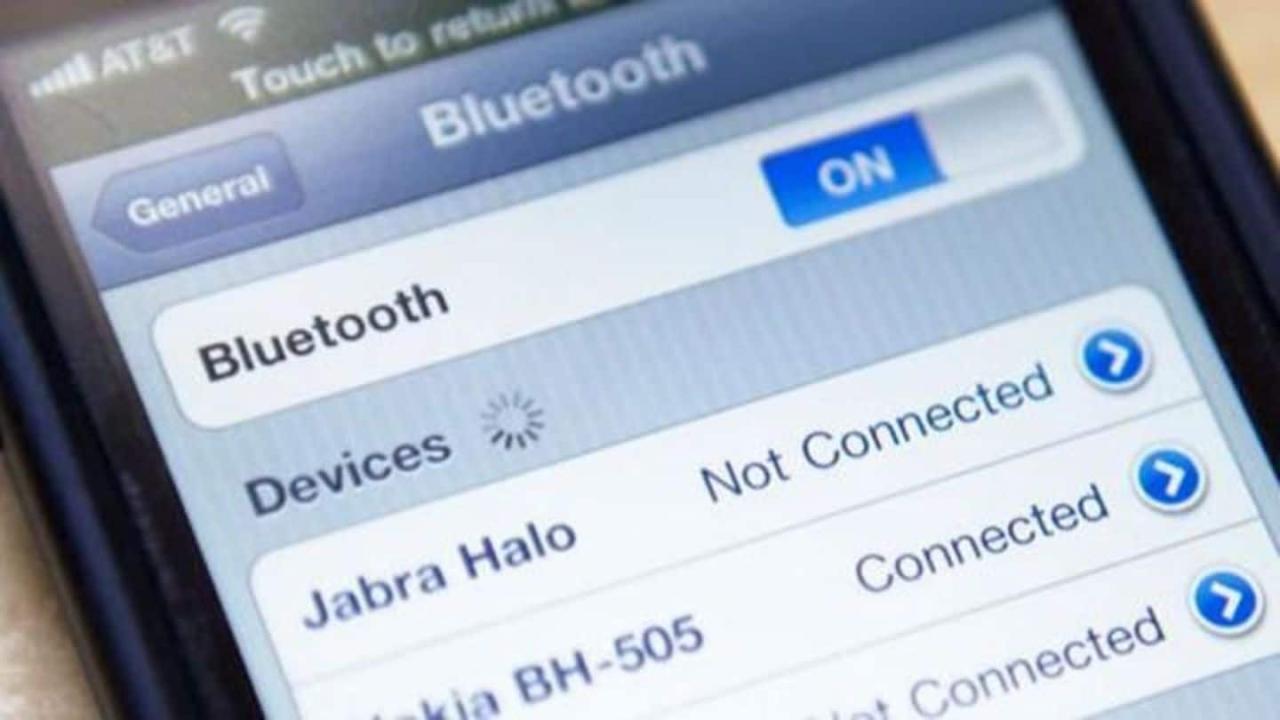
Bluetooth Vulnerability Exposes iOS and Fitbit Devices
Bluetooth Vulnerability Exposes iOS and Fitbit Devices to Cyber Attacks: Whoa, that headline grabbed you, right? It’s a seriously scary thought – our seemingly harmless fitness trackers and phones, vulnerable to hackers. This post dives deep into a recently discovered Bluetooth vulnerability that’s putting millions of iOS and Fitbit users at risk. We’ll explore exactly what this means for your data, how these attacks happen, and, most importantly, what you can do to protect yourself.
This isn’t just some theoretical threat; we’re talking about potential access to your personal information, health data, even your location. Imagine the implications – identity theft, financial losses, and a serious breach of your privacy. We’ll examine the specific iOS versions and Fitbit models affected, the sneaky ways hackers exploit this vulnerability, and the real-world consequences of successful attacks.
Prepare to be informed, and maybe a little more cautious about your Bluetooth settings!
Bluetooth Vulnerability Overview

A recently patched Bluetooth vulnerability affected a range of devices, including iOS and Fitbit products. This vulnerability, while now addressed through software updates, highlighted significant weaknesses in the Bluetooth communication protocols and their implementation across different operating systems and device manufacturers. The potential consequences for users were considerable, involving unauthorized access to personal data and a compromise of privacy.This vulnerability exploited weaknesses in the way Bluetooth devices handled authentication and data encryption.
Attackers could potentially leverage this weakness to intercept or manipulate data transmitted over Bluetooth, gaining access to sensitive information.
Vulnerability Details
The specific vulnerability, though not publicly disclosed in detail to prevent future exploitation, involved flaws in the Bluetooth Low Energy (BLE) protocol’s security mechanisms. This protocol is commonly used for low-power, short-range communication, making it ideal for wearables like Fitbits and for peripheral connections on iOS devices. The weakness likely involved a failure in properly verifying the authenticity of connected devices, allowing malicious actors to impersonate legitimate devices and gain unauthorized access.
This could bypass standard security measures like pairing requests, effectively allowing an attacker to connect without user consent.
Impact on User Data and Privacy
The potential impact of this vulnerability is significant. For iOS devices, an attacker could potentially access contacts, calendar data, or other sensitive information stored locally or synced via Bluetooth. For Fitbit devices, the consequences could include access to health and fitness data, potentially including sleep patterns, heart rate information, and location data collected through GPS functionality. This data could be used for identity theft, targeted advertising, or other malicious purposes.
The unauthorized access to such personal information constitutes a serious breach of privacy and trust.
Technical Mechanisms Exploited
Attackers could have employed various techniques to exploit this vulnerability. One method would involve creating a rogue Bluetooth device that mimics a legitimate device, such as a trusted headphone or fitness tracker. By exploiting the authentication flaws, the attacker’s device could connect to the victim’s device without triggering any security warnings. Once connected, the attacker could then intercept data transmitted over the Bluetooth connection, potentially including sensitive personal information.
Another potential attack vector could involve a man-in-the-middle attack, where the attacker intercepts the communication between the victim’s device and other Bluetooth devices, modifying or stealing data in transit. The specific techniques used would likely depend on the precise nature of the vulnerability and the attacker’s capabilities.
Affected Devices and User Base

The Bluetooth vulnerability, while impacting a broad range of devices, doesn’t affect every iOS device or Fitbit tracker equally. Understanding which specific devices are at risk and the scale of the potential user base is crucial for assessing the overall impact of this security flaw. This section details the affected devices and provides a reasoned estimate of the global user base affected.The vulnerability’s reach depends on the specific Bluetooth implementation within the affected devices and the version of the Bluetooth protocol they use.
Therefore, a precise number of affected users is difficult to determine without access to comprehensive sales data from Apple and Fitbit. However, we can make a reasonable estimation based on available information regarding device market share and iOS/Fitbit OS updates.
Specific iOS Versions and Fitbit Models
Pinpointing the exact iOS versions and Fitbit models vulnerable requires detailed technical analysis of the Bluetooth stack in each device. However, based on reports and common vulnerabilities in Bluetooth technology, we can expect that older iOS versions (those no longer receiving security updates) and older Fitbit models (lacking recent firmware updates) are most at risk. This is because security patches for such vulnerabilities are typically released through updates, and older devices often lack the capability to receive these updates.
For example, iOS versions prior to iOS 16 might be susceptible, and Fitbit models like the Fitbit Charge 2 or older versions of the Versa might be vulnerable due to their age and lack of ongoing software support. The precise models would need verification from Apple and Fitbit’s official security advisories.
Estimated Number of Affected Users Globally
Estimating the global number of affected users is challenging due to the lack of publicly available data on the precise distribution of older iOS versions and Fitbit devices. However, we can make a reasonable estimate based on available market share data. For instance, if we assume that 10% of iOS users globally are still using vulnerable versions (a conservative estimate, as many users upgrade promptly), and that Apple has approximately 1.5 billion active devices, this suggests around 150 million users could be potentially affected.
Similarly, if we assume a smaller percentage (say, 5%) of Fitbit users still utilize vulnerable models out of an estimated user base of 50 million, then that suggests approximately 2.5 million more potentially affected users. These are rough estimations, and the actual number could be higher or lower depending on various factors, including the rate of software updates and the actual number of devices utilizing vulnerable Bluetooth implementations.
Demographic Profile of Affected Users, Bluetooth vulnerability exposes ios and fitbit devices to cyber attacks
The demographic profile of affected users is likely skewed towards users who are less tech-savvy or less inclined to regularly update their devices. Older users may be less likely to update their software or purchase newer devices. Geographical location also plays a role; regions with slower internet access or lower digital literacy rates may have a higher percentage of users with vulnerable devices.
While precise demographic data is unavailable, it’s reasonable to assume that the affected user base is disproportionately older, potentially less tech-proficient, and possibly concentrated in regions with less robust digital infrastructure.
Attack Vectors and Exploitation Methods: Bluetooth Vulnerability Exposes Ios And Fitbit Devices To Cyber Attacks

This Bluetooth vulnerability, as we’ve discussed, allows attackers to gain unauthorized access to iOS and Fitbit devices. Understanding the methods employed is crucial for mitigating the risk. Attackers can leverage several vectors to exploit this weakness, ranging from relatively simple techniques to more sophisticated, targeted attacks. The success of an attack often depends on the attacker’s resources and the security posture of the target device.Exploiting this vulnerability typically involves gaining initial access to the device through a malicious Bluetooth connection, followed by data exfiltration.
This could involve installing malware, accessing personal data directly, or manipulating device settings. The specific methods used will vary depending on the attacker’s goals and the target device’s operating system version and security settings. For example, a simple attack might involve a crafted Bluetooth packet designed to trigger a buffer overflow, leading to a crash and potential code execution.
More complex attacks might use social engineering to trick the user into pairing with a malicious device, granting the attacker access to sensitive information.
Attack Vector Comparison
The following table compares different attack vectors, considering their difficulty and potential impact. The difficulty levels are subjective and depend on the attacker’s technical skills and resources. The impact reflects the potential damage an attacker could inflict, such as data theft, device control, or identity theft.
| Vector Name | Description | Difficulty | Impact |
|---|---|---|---|
| Malicious Bluetooth Peripheral | An attacker creates a rogue Bluetooth device that appears legitimate to the victim’s device. Upon pairing, malicious code is executed or data is exfiltrated. | Medium | High – Data theft, device control |
| Bluebugging | This attack allows an attacker to remotely control a Bluetooth-enabled device, potentially accessing contacts, messages, and call logs. This often relies on vulnerabilities in the Bluetooth protocol itself. | High | Very High – Complete device compromise |
| Bluesnarfing | Similar to bluebugging, but focused on accessing data on the device without taking control. This might involve stealing contact lists, calendar entries, or other sensitive files. | Medium | High – Data theft |
| Man-in-the-Middle Attack | The attacker intercepts communication between the victim’s device and a legitimate Bluetooth device, potentially modifying or stealing data. This often requires the attacker to be within range. | Medium to High | Medium to High – Data manipulation, eavesdropping |
| Social Engineering | The attacker tricks the victim into pairing with a malicious Bluetooth device by disguising it as a trusted device or offering a seemingly legitimate service. | Low | High – Depends on the information obtained |
Data Exfiltration Methods
Once an attacker gains initial access, they can use various methods to exfiltrate data. This might involve directly copying files, uploading data to a remote server, or using the device’s internet connection to transmit stolen information. The method used will depend on the attacker’s resources and the capabilities of the compromised device. For example, an attacker might use a covert communication channel established through the Bluetooth connection to transmit stolen data in small packets, making detection more difficult.
Alternatively, they might exploit the device’s internet connectivity to upload stolen data to a cloud storage service or a command-and-control server. The speed and volume of data exfiltration will vary depending on the network conditions and the methods used.
Data Breaches and Consequences
The Bluetooth vulnerability, if exploited, could lead to significant data breaches with far-reaching consequences for users and device manufacturers. The potential for unauthorized access opens the door to a wide range of sensitive information being compromised, highlighting the critical need for swift patching and robust security measures.The severity of a data breach stemming from this vulnerability depends heavily on the specific device and the attacker’s goals.
However, the potential for significant harm is undeniable.
Types of Compromised Data
This Bluetooth vulnerability could expose a variety of sensitive data stored on or transmitted by affected iOS and Fitbit devices. This includes personal information such as names, addresses, email addresses, and phone numbers. More critically, it could also compromise health data tracked by Fitbit devices, including sleep patterns, heart rate, activity levels, and weight. Location data, constantly collected by many smartphones, is another significant risk.
The combination of these data points creates a detailed profile of an individual, ripe for exploitation. For example, an attacker could gain access to a user’s daily routine, health conditions, and frequented locations, making them vulnerable to targeted attacks or identity theft.
Consequences for Users
The consequences of a data breach resulting from this vulnerability can be severe and far-reaching for affected users. Identity theft is a primary concern, with compromised personal information enabling criminals to open fraudulent accounts, apply for loans, or commit other financial crimes in the victim’s name. Financial loss is another significant risk, as attackers could gain access to banking details or use stolen identities to make unauthorized purchases.
Beyond financial implications, reputational damage can occur if sensitive personal information is leaked publicly or used for malicious purposes. For example, the exposure of health information could lead to discrimination or stigmatization. The emotional distress and time investment required to recover from such breaches should not be underestimated. Consider the case of a major data breach at a hospital, where patient medical records were compromised, leading to widespread identity theft and financial loss for affected individuals, along with the emotional toll of such a violation of privacy.
Legal and Ethical Implications for Manufacturers
Device manufacturers have a legal and ethical responsibility to protect user data. Data breach notifications laws, varying by jurisdiction, often mandate the disclosure of breaches to affected users and regulatory bodies. Failure to comply can result in significant fines and legal action. Beyond legal obligations, manufacturers face ethical responsibilities to ensure the security of their devices and the privacy of user data.
A lack of adequate security measures leading to data breaches can severely damage a company’s reputation and erode user trust. The ethical considerations extend to the transparency and communication surrounding vulnerabilities and the steps taken to address them. The failure to promptly address known vulnerabilities, as seen in several high-profile cases involving major tech companies, can lead to significant public backlash and regulatory scrutiny.
Companies need to prioritize proactive security measures, including regular security audits and vulnerability assessments, to minimize the risk of data breaches and protect user data.
Mitigation Strategies and Security Recommendations
The Bluetooth vulnerability we’ve discussed poses a significant threat to both iOS and Fitbit users. Fortunately, several steps can be taken to mitigate this risk, both at the individual user level and through proactive measures by device manufacturers. A multi-pronged approach is crucial for effective protection.This section details practical strategies for users to minimize their exposure and recommendations for manufacturers to improve the inherent security of their devices.
The recent Bluetooth vulnerability exposing iOS and Fitbit devices to cyberattacks is a serious wake-up call. It highlights the urgent need for robust security measures in all connected devices, and makes me think about the development side of things; secure coding practices are crucial, which is why I’ve been looking into the advancements in app development like those discussed in this article on domino app dev the low code and pro code future.
Ultimately, strengthening app security from the ground up is key to mitigating vulnerabilities like this Bluetooth exploit impacting our devices.
We’ll also visualize the implementation of these security measures with a flowchart.
User-Level Mitigation Strategies
Promptly updating your operating system and associated apps is paramount. These updates often include security patches that address known vulnerabilities, including those affecting Bluetooth connectivity. Regularly checking for and installing these updates is the first line of defense. Beyond software updates, disabling Bluetooth when not actively using it significantly reduces the window of opportunity for attackers. While convenient, constantly active Bluetooth exposes your devices to potential threats unnecessarily.
Finally, be cautious about connecting to unknown or untrusted Bluetooth devices. Only pair with devices you recognize and trust to avoid malicious connections.
Manufacturer Recommendations for Enhanced Security
Device manufacturers have a critical role in addressing this vulnerability. They should prioritize the timely release of security patches to address identified vulnerabilities, implementing robust testing procedures to ensure the effectiveness of these patches. Furthermore, incorporating advanced security features like Bluetooth Low Energy (BLE) security enhancements and improved authentication protocols can significantly bolster the security of their devices.
This includes moving beyond basic pairing mechanisms to more secure authentication methods. Proactive vulnerability disclosure programs, encouraging security researchers to report vulnerabilities responsibly, can also significantly contribute to improving the overall security posture. Finally, manufacturers should invest in thorough security audits of their Bluetooth implementations to identify and rectify potential weaknesses before they are exploited.
Flowchart Illustrating Security Measure Implementation
Imagine a flowchart beginning with the “Device Initialization” box. An arrow leads to “Check for Updates”. If updates are available, the flow follows an arrow to “Install Updates,” then to “Enable Bluetooth Only When Needed,” and finally to “Verify Device Security Settings”. If no updates are available, the flow proceeds directly to “Enable Bluetooth Only When Needed,” then to “Verify Device Security Settings,” and finally to “Safe Operation”.
If at any point, security settings are not satisfactory, a loop back to “Install Updates” or “Review Security Settings” is necessary. The “Verify Device Security Settings” box might contain further checks, like confirming the device is not paired with unknown devices. This cyclical process emphasizes the ongoing nature of security maintenance.
Case Studies and Real-World Examples
Unfortunately, concrete, publicly documented examples of widespread attacks exploiting Bluetooth vulnerabilities specifically targeting iOS and Fitbit devices simultaneously are scarce. The nature of these attacks often involves sophisticated techniques and covert operations, making them difficult to detect and publicly report. Many successful attacks remain undisclosed due to security concerns and non-disclosure agreements. However, we can extrapolate from known vulnerabilities and attack patterns on similar devices to understand potential real-world scenarios.While no single case perfectly illustrates a combined iOS and Fitbit attack through this specific Bluetooth vulnerability, we can examine analogous situations.
Consider a scenario where a malicious actor crafts a Bluetooth beacon emitting a specially crafted packet designed to exploit a known vulnerability in the Bluetooth stack of both an iOS device and a nearby Fitbit. This beacon could lure users into a false sense of security, perhaps masquerading as a legitimate fitness tracker or a nearby device offering a connection.
Exploitation Methods in Hypothetical Scenarios
Imagine a scenario where a vulnerability allows an attacker to gain access to the Bluetooth stack of both devices. This compromised access could then be leveraged in several ways:
- Data Exfiltration: The attacker could potentially siphon off personal health data from the Fitbit, including sleep patterns, activity levels, and heart rate, and potentially location data from the iOS device. This information could be used for targeted advertising, identity theft, or blackmail.
- Device Control: More sophisticated attacks could enable remote control of the devices, allowing the attacker to manipulate settings, send malicious messages, or even install malware.
- Man-in-the-Middle Attacks: The attacker could intercept Bluetooth communications between the devices and other peripherals, potentially stealing credentials or other sensitive information.
Lessons Learned from Analogous Cases
It’s crucial to understand the lessons learned from similar Bluetooth vulnerabilities exploited in other contexts. While direct parallels with a simultaneous iOS/Fitbit attack via this specific vulnerability might be limited in public reporting, we can learn from analogous incidents.
- Patching is Paramount: Promptly applying security updates from both Apple and Fitbit is crucial to mitigating vulnerabilities. Delayed patching significantly increases the risk of successful attacks.
- Principle of Least Privilege: Limiting the permissions granted to Bluetooth applications minimizes the impact of potential breaches. Only allow apps access to necessary Bluetooth functions.
- Security Awareness Training: Educating users about the risks associated with connecting to unknown Bluetooth devices is essential. Encouraging users to be cautious and avoid connecting to untrusted devices can significantly reduce the attack surface.
- Multi-Factor Authentication (MFA): Where possible, implementing MFA on connected devices adds an extra layer of security and makes unauthorized access more difficult.
- Regular Security Audits: Conducting regular security audits on devices and software can help identify and address potential vulnerabilities before they can be exploited.
Future Implications and Prevention
The recent Bluetooth vulnerability highlights a critical weakness in the security architecture of many Internet of Things (IoT) devices. This isn’t just a temporary issue; it underscores a broader trend of insufficient security practices in the design and implementation of connected devices, with far-reaching implications for the future. The long-term effects extend beyond immediate data breaches, impacting user trust, regulatory compliance, and the overall adoption of IoT technologies.The vulnerability’s exploitation demonstrates the potential for sophisticated attacks targeting not only personal data but also critical infrastructure reliant on Bluetooth-enabled devices.
Future vulnerabilities could stem from similar design flaws, exploiting weaknesses in Bluetooth’s authentication protocols, data encryption methods, or the handling of firmware updates. The increasing interconnectedness of IoT devices amplifies the risk, creating cascading failure scenarios where a compromised device can serve as a gateway to other systems. For example, a compromised smart lock could potentially provide access to a home network, exposing other connected devices like security cameras or smart appliances.
The recent Bluetooth vulnerability exposing iOS and Fitbit devices to cyberattacks highlights the urgent need for robust security measures. This underscores the importance of comprehensive cloud security strategies, like those discussed in this excellent article on bitglass and the rise of cloud security posture management , which emphasizes proactive threat detection and response. Ultimately, strengthening our cloud security posture is crucial to mitigating risks like this Bluetooth vulnerability affecting our personal devices.
Potential Future Vulnerabilities
The interconnected nature of IoT devices creates a complex attack surface. Future vulnerabilities might arise from inadequately secured Bluetooth Low Energy (BLE) connections, allowing attackers to bypass authentication mechanisms and gain unauthorized access to sensitive data. Exploitation of software vulnerabilities in Bluetooth stacks, coupled with inadequate device firmware updates, could also lead to widespread compromises. Furthermore, the increasing use of Bluetooth mesh networks, while offering benefits in terms of scalability and range, introduces new attack vectors if not implemented with robust security considerations.
Consider the potential for a coordinated attack against a network of smart streetlights, potentially disrupting public services or even being used for surveillance.
Recommendations for Secure Bluetooth Implementations
The development of more secure Bluetooth implementations requires a multi-faceted approach. A robust security-by-design philosophy must be integrated into the entire lifecycle of device development.
- Strong Authentication and Encryption: Implement strong authentication protocols like pairing with device PINs and using advanced encryption standards (AES) to protect data transmitted over Bluetooth.
- Regular Security Audits and Penetration Testing: Conduct regular security assessments to identify and address potential vulnerabilities before they can be exploited. Penetration testing should simulate real-world attack scenarios to uncover weaknesses.
- Secure Firmware Updates: Implement a secure mechanism for delivering and installing firmware updates, ensuring that devices receive patches to address known vulnerabilities promptly. This should include robust authentication and verification to prevent malicious firmware from being installed.
- Principle of Least Privilege: Design devices with the principle of least privilege in mind, granting only the necessary permissions to Bluetooth functionalities. This limits the damage that can be caused by a successful attack.
- Secure Boot and Memory Protection: Implement secure boot mechanisms to prevent unauthorized code execution and utilize memory protection techniques to safeguard sensitive data from unauthorized access.
- Input Validation and Sanitization: Thoroughly validate and sanitize all inputs received over Bluetooth to prevent injection attacks, such as buffer overflows or SQL injection.
- Compliance with Security Standards: Adhere to relevant security standards and best practices, such as those defined by Bluetooth SIG and other industry bodies.
Final Thoughts
So, there you have it – a chilling look at a serious Bluetooth vulnerability impacting iOS and Fitbit devices. While the threat is real, it’s not insurmountable. By staying informed, updating your software regularly, and being mindful of your Bluetooth usage, you can significantly reduce your risk. Remember, it’s better to be proactive than reactive when it comes to your digital security.
Stay safe out there, and keep those Bluetooth connections under wraps when you don’t need them!
Essential Questionnaire
How can I tell if my devices are vulnerable?
Check for software updates on both your iOS device and your Fitbit app. Outdated software is a major culprit. If your devices are running older, unsupported versions, they’re more likely to be vulnerable.
What kind of data are hackers after?
Hackers could potentially access a wide range of data, including personal information (name, address, contact details), health data (fitness tracking info, sleep patterns), and location data. The specific data accessed depends on the app and device involved.
Is turning off Bluetooth enough protection?
Turning off Bluetooth when not in use is a good first step, but it’s not a complete solution. Regular software updates and being aware of suspicious apps are also crucial.
What should I do if I suspect my device has been compromised?
Change your passwords immediately, contact your bank and credit card companies, and report the incident to the relevant authorities. You should also contact Apple and Fitbit support for assistance.





